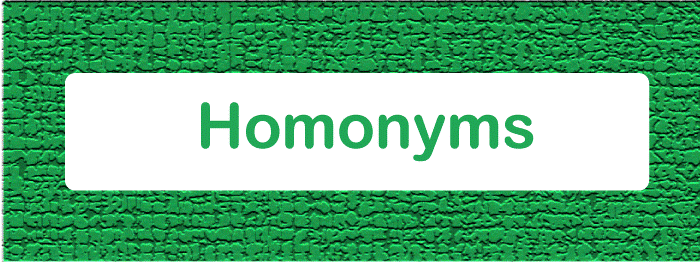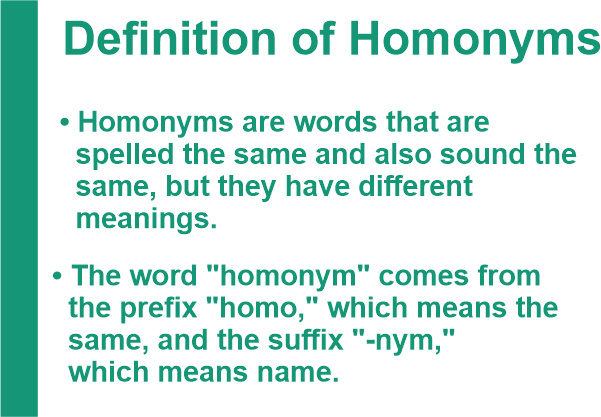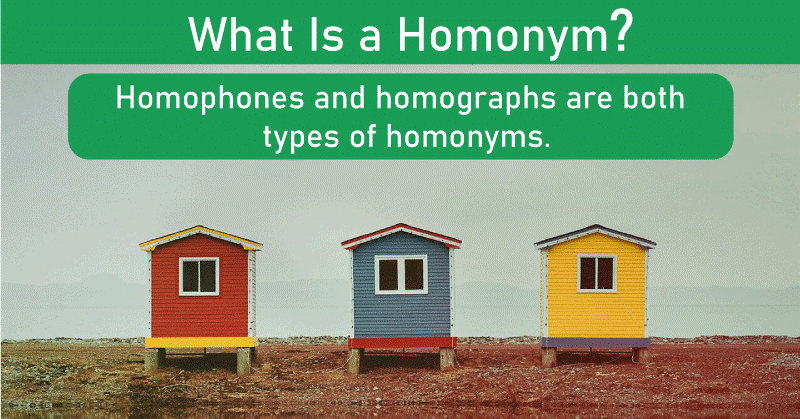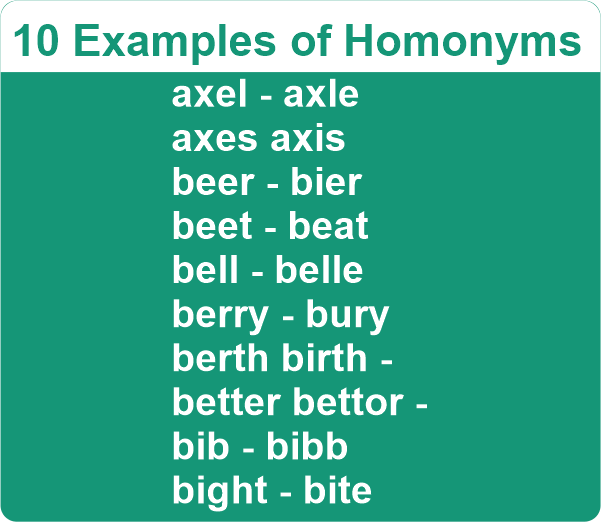HomonymsThe English language enjoys reusing words. A bat is a flying animal, as well as a flat wooden club used to strike balls. Park can refer to both "a grassy area" and "a way to place a vehicle." And rock is both a substance and a type of music. These are all homonyms, or words that have the same spelling or sound but different definitions. 
While homonyms might be confusing at times, they can indeed make writing more rhythmic or entertaining. You can write the following sentence using homonyms: He could barely bear the sight of the bear bare its mouth. ...and it will be perfectly correct. What Exactly Is a Homonym?A homonym is defined as "one of two or more words spelt and pronounced similarly but with different meanings." To further complicate matters, homonyms are divided into two types: homophones and homographs. The name is derived from the Greek homnymon (homnymos' neuter), which implies "bearing the same name." The prefix homo- implies "same," and the suffix -nym implies "name" in Greek. Knowing these roots also allows us to comprehend the subclasses homophone (homo implies "same"; phone implies "voice or sound") and homograph (graph from grapho, which implies "write"). Read on to know more about those distinctions. Homonyms are terms that have the same pronunciation or spelling (for example, "maid" and "made") (e.g., "lead weight" and "to lead"). When two homonyms share the same sound, they are referred to as "homophones." When two words share the same spelling, they are referred to as "homographs." (Homographs having distinct sounds (for example, "tear drop" and "to tear a hole") are referred to as "heteronyms." Therefore, it is conceivable for a homonym to be both a homophone (same sound) as well as a homograph (same spelling), e.g., "dracula bat" and "baseball bat". 
What Exactly Is the Distinction Between Homonyms, Homographs, And Homophones?We've finally figured out what a homonym is. But before we get into some homonym instances, it's crucial to understand that homonyms are classified into two types: homographs and homophones. Let's look at the differences between these two similar-sounding phrases, so we don't get them mixed up. HomographsWhile homonyms can have multiple spellings, homographs are terms that share a spelling but vary in pronunciation. Because the term 'graph' in homograph implies written, these terms are composed in the same way. The homographs 'bow,' 'tear," record,' and 'bark,' for instance, all have at least two distinct meanings. Regardless of meaning or pronunciation, the terms are all spelled the same. HomophonesHomophones are terms that have the same pronunciation or sound the same irrespective of spelling. In homophones, the word 'phone' refers to sound. Words like 'write' and 'right,' 'knight' and 'night,' and see and'sea' are examples of homophones. Even though they're spelled differently, they sound the same when spoken aloud. Children frequently mix up homophones since they normally utilize sounds to establish word spelling, which is not possible with these words. You must consider the context surrounding the word to establish its proper spelling while writing it down a homograph as well as a homophone 
HomonymsHomonyms are words that are both homographs and homophones. These terms are both spelled and spoken the same way. The only distinction between these terms is their meaning, and the only way to determine which one is meant is to read the remainder of the text or listen more carefully to acquire context clues. How to Write with HomonymesMake sure you understand the context: To make sense, homonyms depend on context. If you have just described the beautiful weather as well as the first flowers blooming, it's doubtful that a reader will be confused about the definition of the word spring. However, if the scene involves bouncing on a trapeze during this beautiful shoulder season, the use of spring may require additional clarification. Use context to help your reader understand difficult words. Use homonyms for fun: Authors can use homonyms to generate wordplay and puns. Lewis Carroll's Alice's Adventures in Wonderland is replete with intentionally mistaken homonyms. In fact, homonyms account for the majority of the story's amusement. Homonyms are also excellent for double entendres. Or the deliberate usage of a term having two meanings. Remember to include the apostrophe: numerous commonly used contractions are homonyms. They're, you're, and it's are homonyms for they are, your, and its, respectively. You aren't required to stress about using the wrong term if you grasp the laws of apostrophes. The same thing happens when possessive words form homonyms with their plurals. Cats, for instance, meaning "many felines," whereas cat's signifies "anything belonging to a single cat." What Are Some Examples of Homonyms?There are various homonyms in the English language. Here's a handy list of a few of the most prevalent homonym words. You'll also be able to tell if these homonyms are homographs, homophones, or both! Addresses- Addresses
Band - Band
Bat - Bat
Nail - Nail
Match - Match
Right - Right
Mean - Mean
Ring- Ring
Rose - Rose
Stalk - Stalk
Clip - Clip
Tie - Tie
Cool - Cool
A Rock - A Rock
Palms - Palms
A Ruler - A Ruler

Why Are Homonyms Important?There are two compelling reasons to be concerned about homonyms. (Reason 1) Homonyms Are a Frequent Source Of Spelling Errors.Homonyms (such as "course" and "coarse") and near homonyms (such as "affect" and "effect") are frequently to blame for literary blunders. Recognizing this lowers your threshold for reaching for a dictionary or Google to determine which of the homophones to use. This list of easily misunderstood terms contains lessons and quizzes on over 200 homonyms and near homonyms that frequently pose problems for writers. (Reason 2) Puns Have the Power To Be Unforgettable.Using a homonym in a headline can make it more interesting and memorable. Doggie trends (Dog-grooming store ) Homophones That Lead to Writing ErrorsSadly, homophones (and words that are virtually homophones) are frequently to blame for writing errors : His plan is beginning to bare fruit. incorrect cross (Must be "bear." ) The beanie compliments your face. incorrect cross (Must be "complements." ) Keep in mind that only homophones can create writing errors. Homographs are unable to do so since their spellings are identical. Homonyms Examples
(These words are homophones.) More information on Homographs, Heteronyms, and HomophonesHere are some additional homographs and homophones (along with heteronyms and non-heteronyms): HomographsThese are terms with similar spellings but distinct meanings. Whenever homographs have distinct sounds, they are referred to as "heteronyms. "
Homographs (Non-heteronyms)Heteronyms are not always homographs (i.e., some of these have the same spelling as well as the sound).
Homophones. (words with same sound)
Next TopicHomonyms and Homophones
|
 For Videos Join Our Youtube Channel: Join Now
For Videos Join Our Youtube Channel: Join Now
Feedback
- Send your Feedback to [email protected]
Help Others, Please Share









